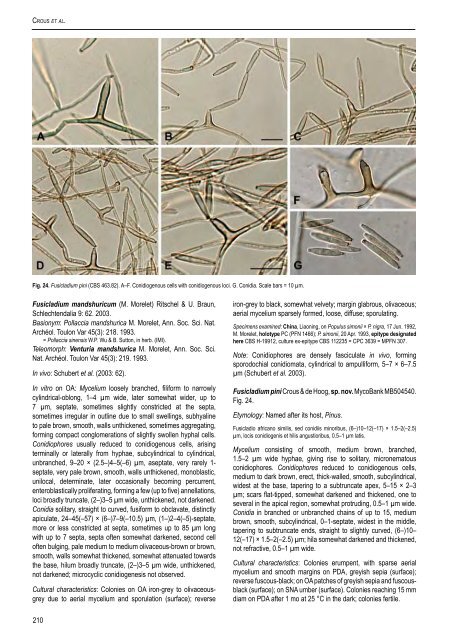The genus Cladosporium and similar dematiaceous ... - CBS - KNAW
The genus Cladosporium and similar dematiaceous ... - CBS - KNAW
The genus Cladosporium and similar dematiaceous ... - CBS - KNAW
You also want an ePaper? Increase the reach of your titles
YUMPU automatically turns print PDFs into web optimized ePapers that Google loves.
Crous et al.<br />
Fig. 24. Fusicladium pini (<strong>CBS</strong> 463.82). A–F. Conidiogenous cells with conidiogenous loci. G. Conidia. Scale bars = 10 µm.<br />
Fusicladium m<strong>and</strong>shuricum (M. Morelet) Ritschel & U. Braun,<br />
Schlechtendalia 9: 62. 2003.<br />
Basionym: Pollaccia m<strong>and</strong>shurica M. Morelet, Ann. Soc. Sci. Nat.<br />
Archéol. Toulon Var 45(3): 218. 1993.<br />
= Pollaccia sinensis W.P. Wu & B. Sutton, in herb. (IMI).<br />
Teleomorph: Venturia m<strong>and</strong>shurica M. Morelet, Ann. Soc. Sci.<br />
Nat. Archéol. Toulon Var 45(3): 219. 1993.<br />
In vivo: Schubert et al. (2003: 62).<br />
In vitro on OA: Mycelium loosely branched, filiform to narrowly<br />
cylindrical-oblong, 1–4 µm wide, later somewhat wider, up to<br />
7 µm, septate, sometimes slightly constricted at the septa,<br />
sometimes irregular in outline due to small swellings, subhyaline<br />
to pale brown, smooth, walls unthickened, sometimes aggregating,<br />
forming compact conglomerations of slightly swollen hyphal cells.<br />
Conidiophores usually reduced to conidiogenous cells, arising<br />
terminally or laterally from hyphae, subcylindrical to cylindrical,<br />
unbranched, 9–20 × (2.5–)4–5(–6) µm, aseptate, very rarely 1-<br />
septate, very pale brown, smooth, walls unthickened, monoblastic,<br />
unilocal, determinate, later occasionally becoming percurrent,<br />
enteroblastically proliferating, forming a few (up to five) annellations,<br />
loci broadly truncate, (2–)3–5 µm wide, unthickened, not darkened.<br />
Conidia solitary, straight to curved, fusiform to obclavate, distinctly<br />
apiculate, 24–45(–57) × (6–)7–9(–10.5) µm, (1–)2–4(–5)-septate,<br />
more or less constricted at septa, sometimes up to 85 µm long<br />
with up to 7 septa, septa often somewhat darkened, second cell<br />
often bulging, pale medium to medium olivaceous-brown or brown,<br />
smooth, walls somewhat thickened, somewhat attenuated towards<br />
the base, hilum broadly truncate, (2–)3–5 µm wide, unthickened,<br />
not darkened; microcyclic conidiogenesis not observed.<br />
Cultural characteristics: Colonies on OA iron-grey to olivaceousgrey<br />
due to aerial mycelium <strong>and</strong> sporulation (surface); reverse<br />
iron-grey to black, somewhat velvety; margin glabrous, olivaceous;<br />
aerial mycelium sparsely formed, loose, diffuse; sporulating.<br />
Specimens examined: China, Liaoning, on Populus simonii × P. nigra, 17 Jun. 1992,<br />
M. Morelet, holotype PC (PFN 1466); P. simonii, 20 Apr. 1993, epitype designated<br />
here <strong>CBS</strong> H-19912, culture ex-epitype <strong>CBS</strong> 112235 = CPC 3639 = MPFN 307.<br />
Note: Conidiophores are densely fasciculate in vivo, forming<br />
sporodochial conidiomata, cylindrical to ampulliform, 5–7 × 6–7.5<br />
µm (Schubert et al. 2003).<br />
Fusicladium pini Crous & de Hoog, sp. nov. MycoBank MB504540.<br />
Fig. 24.<br />
Etymology: Named after its host, Pinus.<br />
Fusicladio africano similis, sed conidiis minoribus, (6–)10–12(–17) × 1.5–2(–2.5)<br />
µm, locis conidiogenis et hilis angustioribus, 0.5–1 µm latis.<br />
Mycelium consisting of smooth, medium brown, branched,<br />
1.5–2 µm wide hyphae, giving rise to solitary, micronematous<br />
conidiophores. Conidiophores reduced to conidiogenous cells,<br />
medium to dark brown, erect, thick-walled, smooth, subcylindrical,<br />
widest at the base, tapering to a subtruncate apex, 5–15 × 2–3<br />
µm; scars flat-tipped, somewhat darkened <strong>and</strong> thickened, one to<br />
several in the apical region, somewhat protruding, 0.5–1 µm wide.<br />
Conidia in branched or unbranched chains of up to 15, medium<br />
brown, smooth, subcylindrical, 0–1-septate, widest in the middle,<br />
tapering to subtruncate ends, straight to slightly curved, (6–)10–<br />
12(–17) × 1.5–2(–2.5) µm; hila somewhat darkened <strong>and</strong> thickened,<br />
not refractive, 0.5–1 µm wide.<br />
Cultural characteristics: Colonies erumpent, with sparse aerial<br />
mycelium <strong>and</strong> smooth margins on PDA, greyish sepia (surface);<br />
reverse fuscous-black; on OA patches of greyish sepia <strong>and</strong> fuscousblack<br />
(surface); on SNA umber (surface). Colonies reaching 15 mm<br />
diam on PDA after 1 mo at 25 °C in the dark; colonies fertile.<br />
210

















